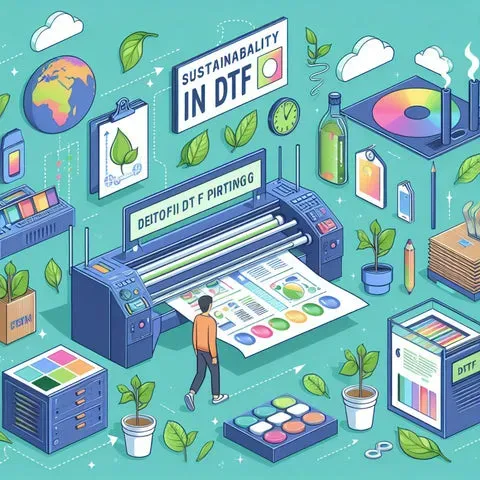The environmental impact of DTF printing has garnered increasing attention as more businesses seek sustainable solutions in the printing industry. As a modern printing method, Direct to Film (DTF) printing promises versatility and high-quality results, yet its ecological footprint raises important questions. Understanding the environmental concerns surrounding DTF printing is crucial for making informed choices that reflect eco-friendly printing methods. This article explores the distinct aspects of DTF printing sustainability, exposing both the advantages and potential pitfalls. By examining DTF printing facts and myths, we aim to provide clarity on how this practice can align with sustainable printing practices.
When discussing the environmental implications of Direct to Film printing, it’s essential to consider its role within the broader context of modern printing techniques. Often referred to as DTF technology, this innovative method utilizes specialized film to transfer designs onto fabrics, allowing for diverse applications in the apparel market. Although it is celebrated for its customization capabilities and efficiency, the ecological impact of this printing approach is layered with complexity. Delving into the concerns related to DTF processes will reveal sustainable practices that can be incorporated while mitigating environmental risks. As such, recognizing the distinction between facts and myths in DTF printing will pave the way for more responsible use and implementation.
Understanding DTF Printing Sustainability
DTF printing, or Direct to Film printing, has emerged as an innovative method for fabric printing that aligns with sustainability goals. This technique reduces water usage significantly compared to traditional printing processes, making it a step towards eco-friendly printing methods. However, it is crucial to recognize that the term “sustainable” is often misused, and not every DTF printer employs practices that uphold environmental integrity. The sustainability of DTF printing largely depends on the inks used, the management of waste materials, and the energy sources powering the equipment.
For those interested in adopting DTF printing, understanding its sustainability implications is essential. Manufacturers are responding to environmental concerns by developing inks that are less harmful to the ecosystem. By choosing DTF printing services that prioritize eco-friendly inks, businesses can help minimize their environmental footprint and encourage sustainable practices within the industry. Additionally, promoting recycling programs for used films can further enhance the sustainability of DTF printing initiatives.
Frequently Asked Questions
What are the environmental impacts of DTF printing?
DTF printing can have significant environmental impacts, including the use of harmful inks, waste generated from film materials, and high energy consumption during the curing process. Addressing these issues with sustainable inks and responsible waste management is crucial for mitigating the ecological footprint.
Is DTF printing considered a sustainable printing method?
While DTF printing can reduce water usage compared to traditional methods, its sustainability largely depends on the practices used in the process. Not all DTF operations are eco-friendly, making it essential to choose manufacturers committed to sustainable printing practices.
How does DTF printing compare with other eco-friendly printing methods?
DTF printing offers lower water consumption than some traditional methods, yet it still generates waste and utilizes energy. Compared to other eco-friendly printing methods, DTF can be more sustainable if sustainable inks and efficient waste management practices are employed.
What are common myths about the environmental impact of DTF printing?
Common myths include the belief that DTF printing is inherently eco-friendly and that all inks are harmful. The truth is that while it can be more sustainable, the actual impact varies based on materials and practices used, and there are eco-friendly ink options available.
What steps can be taken to minimize environmental concerns related to DTF printing?
Minimizing environmental concerns in DTF printing involves using eco-friendly inks, implementing effective waste management strategies, and optimizing energy consumption. These actions can help reduce the overall environmental impact of the DTF printing process.
Are there sustainable practices that can improve the environmental footprint of DTF printing?
Yes, adopting sustainable practices such as using biodegradable film materials, recycling unused films, and sourcing eco-friendly inks can significantly improve the environmental footprint of DTF printing.
| Key Points | Details |
|---|---|
| What is DTF Printing? | A modern printing method that transfers designs onto textiles from a special film, known for its versatility and high-quality output. |
| Environmental Concerns | 1. Ink Composition: Inks may contain harmful chemicals. 2. Film Waste: Accumulation of unutilized films can increase landfill waste. 3. Energy Consumption: High energy use, particularly during ink curing increases carbon footprint. |
| Myths vs. Facts | – Myth: DTF printing is eco-friendly. Fact: It depends on materials and processes used. – Myth: All inks are harmful. Fact: Sustainable inks are available. – Myth: DTF eliminates waste. Fact: It still produces waste and inefficient processes increase it. |
| Advantages of DTF Printing | 1. Lower Water Use: Reduces water consumption compared to traditional methods. 2. Efficient Customization: On-demand printing minimizes unsold inventory and waste. |
| Conclusion | DTF printing’s environmental impact is complex, with both advantages and drawbacks. Sustainable practices can mitigate negatives and lead to a reduced ecological footprint. |
Summary
The environmental impact of DTF printing is a critical topic that encompasses both advantages and challenges within the printing industry. It highlights the necessity for sustainable practices to combat the shortcomings associate with mainstream processes. As the demand for DTF printing grows, recognizing its potential for both lower water usage and the risks involved regarding harmful inks and film waste is crucial. By actively pursuing eco-friendly options and responsibly managing resources, consumers and businesses can contribute toward a more sustainable future in DTF printing.



